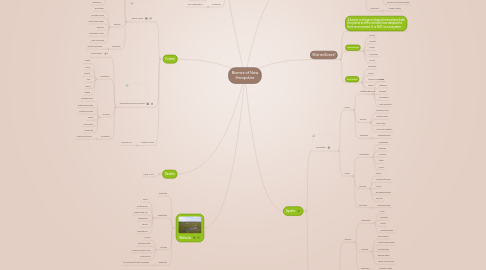
1. Tundra
1.1. #Tundra
1.2. Vegetation
1.2.1. Low-growing plants
1.2.2. Mosses and Lichen
1.2.3. Black Spruce
1.2.4. Balsam Fir
1.2.5. Bigelow's Sedge
1.3. Animals
1.3.1. Voles
1.3.2. Eastern Milk Snake
1.3.3. Cottontail Hare
1.3.4. Common Fieldmouse
1.3.5. Bicknell's Thrush
1.4. Examples
1.4.1. Mnt. Washington
2. Wetlands
2.1. #Wetland
2.2. Vegetation
2.2.1. Ferns
2.2.2. Buttonbush
2.2.3. White Pond Lily
2.2.4. Jewelweed
2.2.5. Beech
2.2.6. Sweet Birch
2.3. Animals
2.3.1. Moose
2.3.2. Spotted Turtle
2.3.3. American Black Duck
2.3.4. Marsh Wren
2.4. Examples
2.4.1. (surrounding) Lake Umbagog
3. Forests
3.1. Boreal Forest
3.1.1. #Boreal
3.1.2. Vegetation
3.1.2.1. Moss Campion
3.1.2.2. Black Spruce
3.1.2.3. Balsam Fir
3.1.2.4. Maleberry
3.1.3. Animals
3.1.3.1. Black Bear
3.1.3.2. Canadian Lynx
3.1.3.3. White-tailed deer
3.1.3.4. Beavers
3.1.3.5. Snowshoe Hares
3.1.3.6. Pine Grosbeak
3.1.4. Examples
3.1.4.1. White Mountains
3.2. Temperate Deciduous Forest
3.2.1. #Temperate
3.2.2. Vegetation
3.2.2.1. Lichen
3.2.2.2. Ferns
3.2.2.3. Shrubs
3.2.2.4. Oak
3.2.2.5. Birch
3.2.2.6. Beech
3.2.3. Animals
3.2.3.1. Woodpeckers
3.2.3.2. White-tailed deer
3.2.3.3. Hawks and owls
3.2.3.4. Foxes
3.2.3.5. Opossums
3.2.3.6. Goldfinch
3.2.4. Examples
3.2.4.1. White Mountains
3.3. Tropical Forest
3.3.1. None in NH
4. Deserts
4.1. None in NH
5. What are Biomes?
5.1. A biome is a large ecological area where both the plants and the animals have adapted to their environment. It is NOT an ecosystem.
5.2. Major Biomes
5.2.1. Desert
5.2.2. Aquatic
5.2.3. Forest
5.2.4. Grassland
5.2.5. Tundra
5.3. Sub-biomes
5.3.1. Wetlands
5.3.2. Ocean
5.3.3. Tropical Rainforest
5.3.4. Alpine
5.3.5. Savanna
6. Aquatic
6.1. Freshwater
6.1.1. Rivers
6.1.1.1. Vegetation
6.1.1.1.1. Algae
6.1.1.1.2. Waterlily
6.1.1.1.3. Bullrush
6.1.1.1.4. Duckweed
6.1.1.1.5. Phytoplankton
6.1.1.2. Animals
6.1.1.2.1. Rainbow trout
6.1.1.2.2. Leopard frog
6.1.1.2.3. River otter
6.1.1.2.4. American alligator
6.1.1.3. Examples
6.1.1.3.1. Pemigewasset
6.1.2. Lakes
6.1.2.1. Vegetation
6.1.2.1.1. Pondweed
6.1.2.1.2. Eelgrass
6.1.2.1.3. Coontail
6.1.2.1.4. Algae
6.1.2.1.5. Milfoil
6.1.2.2. Animals
6.1.2.2.1. Perch
6.1.2.2.2. Smallmouth bass
6.1.2.2.3. Loons
6.1.2.2.4. Bufflehead ducks
6.1.2.2.5. Sunfish
6.1.2.3. Examples
6.1.2.3.1. Winnipesaukee
6.2. Saltwater
6.2.1. Oceans
6.2.1.1. Vegetation
6.2.1.1.1. Kelp
6.2.1.1.2. Eelgrass
6.2.1.1.3. Algae
6.2.1.1.4. Phytoplankton
6.2.1.2. Animals
6.2.1.2.1. Coral polyps
6.2.1.2.2. Hammerhead shark
6.2.1.2.3. Mandarinfish
6.2.1.2.4. Basking shark
6.2.1.2.5. Yellow-finned tuna
6.2.1.3. Examples
6.2.1.3.1. Atlantic Ocean
6.2.2. Estuaries
6.2.2.1. Vegetation
6.2.2.1.1. Mangroves
6.2.2.1.2. Sea rush
6.2.2.1.3. Purple loosestrife
6.2.2.1.4. Cordgrass
6.2.2.1.5. Seagrass
6.2.2.2. Animals
6.2.2.2.1. Oysters
6.2.2.2.2. Pelicans
6.2.2.2.3. Fiddler crabs
6.2.2.2.4. Harbor seal
6.2.2.2.5. Egret
6.2.2.2.6. Flounder
6.2.2.3. Examples
6.2.2.3.1. Great Bay Estuary
7. Grasslands
7.1. Agricultural Fields
7.1.1. Vegetation
7.1.1.1. Corn
7.1.1.2. Wheat
7.1.2. Animals
7.1.2.1. Mice
7.1.2.2. White-tailed Deer
7.1.2.3. Common Crow
7.1.2.4. Various Sparrows
7.1.3. Examples
7.1.3.1. Cornfields near Mya's
7.2. Other (airports, landfills, etc.)
7.2.1. Vegetation
7.2.1.1. Grass
7.2.2. Animals
7.2.2.1. White-tailed Deer
7.2.2.2. Mice
7.2.2.3. Common Crow
7.2.2.4. Various Sparrows
7.2.2.5. Eastern Cottontail Rabbit
7.2.3. Examples
7.2.3.1. Nashua Airpor
